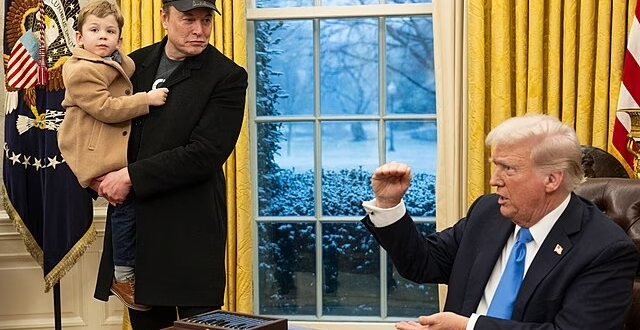Since returning to office last month, President Donald Trump has set off a whirlwind of changes that have touched nearly every corner of the White House—from sweeping policy shifts to unexpected changes in interior design. One of the most talked-about moves came when the 78-year-old President announced that the historic Resolute Desk had been removed from the Oval Office. In its place, at least for now, sits the C&O Desk—a well-known piece of furniture that will serve as a temporary substitute while the iconic Resolute Desk undergoes a light refurbishment.
This decision has ignited widespread debate among historians, political commentators, and everyday citizens alike. For many, the Resolute Desk is not merely a piece of furniture; it is a symbol of American heritage and continuity. Crafted from the timbers of the British exploration ship HMS Resolute and presented to President Rutherford B. Hayes by Queen Victoria in 1880, the desk has graced the offices of almost every U.S. President since its arrival. Over the years, figures ranging from Barack Obama to Joe Biden have used it, and its presence in the Oval Office has become an enduring emblem of American history.
Now, President Trump’s bold decision to temporarily replace the Resolute Desk with the C&O Desk is stirring up both nostalgia and controversy. In a recent post on Truth Social, he explained that the Resolute Desk was removed for some “vital” refurbishments. “A President, after election, gets a choice of 1 in 7 desks,” Trump quipped—adding humorously that, in reality, the choice was more like one in six. He went on to say, “This desk, the C&O, which is also well-known and was used by President George H.W. Bush and others, has been temporarily installed in the White House while the Resolute Desk is being lightly refinished. This is a beautiful, but temporary replacement!”
A Symbol of American Heritage
The Resolute Desk carries a legacy that spans nearly 150 years. Its origins are steeped in international diplomacy and exploration. Salvaged from the abandoned ship HMS Resolute, the desk was presented as a gift to the United States by Queen Victoria in the late 19th century—a symbol of lasting friendship between Britain and America. Over the decades, this desk has witnessed countless historical moments. It has served as the backdrop for important decisions and has been a silent observer in the Oval Office during crises and celebrations alike.
For many Americans, the Resolute Desk represents the continuity of the nation’s history. It stands for the ideals of perseverance, unity, and the shared heritage that links every president to those who came before. Its design, with its elegant curves and the rich patina of aged wood, is a testament to fine craftsmanship. When it graces the Oval Office, it reassures us that even as times change, the values of American history remain constant.
A Temporary Replacement: The C&O Desk
In a twist that few would have expected, President Trump’s administration decided to swap out this historic piece of furniture with the C&O Desk. The C&O Desk is no stranger to presidential lore either—it has been used by previous presidents, including George H.W. Bush. Its design is familiar and dignified, though it does not carry the same deep historical roots as the Resolute Desk.
By placing the C&O Desk in the Oval Office, President Trump has signaled that while history is important, practical considerations must also be met. The Resolute Desk is currently set to receive a “vital” refresh—an update to ensure it remains both functional and preserved for future generations. In Trump’s view, even objects with rich historical significance sometimes need a little modern care. His decision to use the C&O Desk as a temporary substitute reflects his broader approach of mixing tradition with innovation—a theme that has defined many of his recent actions since returning to office.
A Curious Timing
What has made this decision even more intriguing is the timing. The announcement about the desk replacement came just days after a widely publicized incident involving Elon Musk’s four-year-old son, often referred to as “Little X.” During a recent visit to the White House for a Q&A session about the Department of Government Efficiency (DOGE), the young boy was captured on video doing something unexpected—he was seen picking his nose and then, rather shockingly, using it to wipe a part of a desk’s surface.
The photos and videos of that moment spread quickly on social media, prompting a mix of humor and criticism. Some online users joked that the desk was clearly showing signs of wear from the child’s mishandling, while others took a more critical view on the propriety of having children in such formal settings. Though it remains unclear if Musk’s son’s antics directly influenced the decision to refurbish the Resolute Desk, the close timing has led many to draw connections between the two events. The juxtaposition of a historical symbol like the Resolute Desk with a moment of modern chaos from an unexpected source has certainly added an extra layer of intrigue to the story.
Public Reactions and Social Media Buzz
The news of the desk swap has set off a flurry of reactions across social media platforms. For many, the Resolute Desk is an iconic symbol of American presidential history, and its removal—even temporarily—has sparked nostalgia and a sense of loss. Fans of the historical artifact lament the idea of it being out of the Oval Office, even as they understand the need for its preservation and maintenance.
On the other hand, some supporters of President Trump have welcomed the change, praising it as a bold move that reflects a commitment to modernization and practical governance. “It’s a fresh start—sometimes even icons need a little update!” one commenter noted. Others humorously referenced Trump’s remark about the presidential desk choices, suggesting that a change in the Oval Office decor is just another example of his unconventional approach to leadership.
The mix of nostalgic sadness, practical acceptance, and humor underscores how deeply ingrained symbols like the Resolute Desk are in our collective consciousness. For many Americans, the desk is not just furniture—it is a tangible link to the past, a reminder of the legacy and history of the presidency. Its temporary replacement with the C&O Desk, therefore, represents a moment of both continuity and change.
Trump’s Flurry of Changes: Beyond the Desk
The change in the Oval Office is just one of many bold moves President Trump has made since returning to office. In his first 100 days back, Trump has signed an unprecedented 73 executive orders, the highest number in over 40 years for that period. These orders cover a wide range of issues, from economic policies to national security measures, and they signal a determined effort to reshape the government according to his vision.
In this context, the decision to refurbish the Resolute Desk is not an isolated act—it fits into a broader narrative of transformation. To some, this move is a clear signal that no tradition is too sacred to be updated if it means improving efficiency and practicality. For others, it is a provocative break with the past, a gesture that challenges the established symbols of American history.
The Historical Significance of the Resolute Desk
To truly appreciate the controversy, it helps to understand the history of the Resolute Desk. Made from wood recovered from the HMS Resolute, a British ship that became stranded in the Arctic, the desk was presented to the United States in 1880 by Queen Victoria as a gesture of goodwill. Over the decades, it has been used by presidents from Rutherford B. Hayes onward, becoming a fixture in the Oval Office and a symbol of continuity and national pride.
Its removal, even temporarily, has profound symbolic implications. For traditionalists, the desk is an artifact that embodies the enduring legacy of the American presidency. Changing it, even for practical reasons, can feel like a disruption of a cherished tradition. Yet, history is not static. Objects, like institutions, sometimes require renewal to continue serving their purpose. The refurbishment of the Resolute Desk can be seen as an effort to preserve it for future generations while also ensuring that it remains a functional part of the modern Oval Office.
Balancing Tradition with Modernity
President Trump’s decision to install the C&O Desk temporarily is a classic example of balancing tradition with modernity. The C&O Desk, used by former President George H.W. Bush among others, carries its own historical weight. While it may not have the same legendary status as the Resolute Desk, it serves as a dignified and well-respected piece of White House history. By choosing the C&O Desk as an interim solution, Trump is sending a message: while we honor our past, we are also willing to make practical changes when needed.
In his statement on Truth Social, Trump made light of the process, joking about the presidential desk options. His comment, “A President, after election, gets a choice of 1 in 7 desks,”—with a humorous correction that it was really one in six—showed that he views this change as both necessary and even somewhat fun. It is a move that, for supporters, reflects a no-nonsense, pragmatic approach to governing.
Looking Ahead: What Does This Mean for the Oval Office?
The Future of the Resolute Desk
As the Resolute Desk undergoes its refurbishment, many are left wondering what changes it might receive. The promise of a “vital” refresh suggests that the desk will be restored to its former glory, perhaps with a few modern touches that help it better serve the demands of a 21st-century president. While details of the refurbishment have not been released, one can expect that care will be taken to preserve the desk’s historical essence while ensuring that it remains a practical tool in the Oval Office.
For historians and preservationists, the process is fascinating. The challenge lies in updating an artifact of such deep historical significance without diminishing its value as a symbol of American heritage. The hope is that the final result will honor the desk’s storied past while making it fit seamlessly into the modern era—a blend of history and innovation that reflects the evolving nature of the presidency.
The Broader Impact on White House Traditions
The temporary replacement of the Resolute Desk is part of a broader series of changes that President Trump has initiated since his return to office. These moves, which range from policy shifts to even changes in the White House’s interior design, underscore a willingness to break with tradition in favor of progress and modernization.
For many, these changes represent a refreshing departure from the status quo—a sign that the administration is not afraid to make bold moves. However, for others, they raise concerns about the preservation of history and the importance of maintaining continuity in symbols that connect current leadership with the nation’s past. The debate over the desk is emblematic of the larger cultural conversation about how best to balance the need for modern efficiency with respect for historical traditions.
Public Reactions and Ongoing Debate
Public reactions to the desk change have been as varied as the political landscape itself. Social media platforms are buzzing with comments—some nostalgic, others pragmatic, and a few downright humorous. Many users expressed sadness at the sight of the Resolute Desk being removed, seeing it as a break from a long tradition of presidential symbolism. “The Resolute Desk is an icon,” one comment read. “It represents the history of our nation, and I’m not sure I like seeing it replaced.”
Conversely, supporters of the change have praised it as a practical decision. “Sometimes even icons need a refresh,” another user remarked, appreciating that the refurbishment could help preserve the desk for future generations. The discussion has evolved into a broader debate about what modern leadership should look like and how historical artifacts can adapt to meet the demands of today’s world.
Reflections on Tradition, Innovation, and Governance
The Role of Symbolism in Politics
The Resolute Desk is more than a functional piece of furniture—it is a powerful symbol of the continuity and resilience of American leadership. For decades, it has been associated with the decision-making processes of the highest office in the land. Its removal, even temporarily, is a significant moment that challenges us to rethink the role of symbols in governance.
Symbols like the Resolute Desk provide a tangible connection to our past. They remind us of the legacy and the values that have shaped the nation. Yet, they are also subject to the same pressures for renewal and modernization that affect every aspect of society. In this light, President Trump’s decision can be seen as an effort to preserve a cherished symbol while ensuring it remains practical and relevant in a modern context.
A Bold Vision for the Future
At its core, this move is part of a bold vision for the future of the White House and the presidency. President Trump’s recent changes, including the refurbishing of the Resolute Desk and the installation of the C&O Desk, signal that he is not content with maintaining tradition for tradition’s sake. Instead, he aims to infuse the Oval Office with a sense of renewal—a reminder that the presidency must evolve to meet the challenges of today’s world.
This vision extends beyond mere aesthetics. It reflects a broader philosophy of governance that values innovation, practicality, and a willingness to break with established norms. For supporters, these changes are a sign of a dynamic administration that is prepared to take decisive action and to implement reforms across the board. For critics, however, the alterations raise questions about the loss of historical continuity and the risks associated with too much change too quickly.
The Conversation Continues
The debate over the desk replacement is far from over. As the Resolute Desk undergoes its refurbishment, and as the C&O Desk holds the place of honor in the Oval Office for the time being, political observers and citizens alike will continue to weigh in on what these changes mean. Do they represent a necessary modernization of a historic institution? Or do they signal a disregard for the traditions that have long been a cornerstone of American leadership?
These questions touch on broader issues of how we value history and innovation in governance. They remind us that every decision—no matter how seemingly minor, such as the choice of a desk—can carry deep symbolic weight. In a time when political discourse is as charged as ever, even changes in interior design can spark nationwide conversations about who we are as a nation and where we are headed.
Conclusion: A Bold Move, a New Chapter, and the Future of American Tradition
Since returning to office last month, President Donald Trump has not shied away from making bold changes. His decision to remove the historic Resolute Desk from the Oval Office and temporarily replace it with the C&O Desk is a move that encapsulates his broader approach to leadership—one that values both tradition and innovation.
For many, the Resolute Desk has been a symbol of American heritage, representing the legacy of every president from Rutherford B. Hayes to Barack Obama. Its removal, even if only temporary, has stirred strong emotions among those who view it as a cherished artifact of national history. Yet, President Trump’s announcement explained that the desk is being given a “vital” refurbishment—a necessary update to ensure it remains in pristine condition for future generations.
In its place, the C&O Desk, which has its own history and has been used by past presidents like George H.W. Bush, now stands as a placeholder. This change is part of a series of bold initiatives Trump has introduced since his return to office—initiatives that span from significant policy shifts to even altering the interior design of the White House. These moves signal a new chapter in American governance, one that seeks to balance the weight of history with the demands of modern leadership.
Adding to the intrigue is the curious timing of the refurbishment announcement. Just days ago, a widely circulated incident involving Elon Musk’s four-year-old son at the White House captured the public’s attention. During a Q&A session about the Department of Government Efficiency, the young boy was seen engaging in behavior that some online users humorously linked to wear and tear on the White House furniture. Whether or not this incident influenced the decision remains unconfirmed, but it certainly added fuel to the already heated discussion about preserving national symbols in a modern age.
Public reaction to the desk change has been mixed. Social media is awash with nostalgia for the Resolute Desk and admiration for its storied past, yet there is also support for practical updates that ensure our national artifacts can meet contemporary needs. The debate is a reflection of the broader tension between preserving tradition and embracing innovation—a tension that is at the heart of many political discussions today.
As we look forward to the refurbished Resolute Desk’s return, we must consider what this change means for the Oval Office and for American governance. Does it signal a break with tradition, or is it a necessary evolution to keep our heritage alive in a world that is constantly changing? President Trump’s bold move certainly sets the stage for further discussion. His willingness to make immediate, tangible changes—down to the very furniture in the Oval Office—underscores his commitment to reshaping the presidency in his own image.
Ultimately, this decision is about more than just replacing a desk. It is about reimagining how history and modernity can coexist within the halls of power. It challenges us to think about what we value in our national symbols and how they can adapt to reflect both our past and our future. Whether you view the change as a break from tradition or as a refreshing update, it is clear that President Trump’s actions are sparking a conversation that will continue to influence American political culture for years to come.
I invite you to share your thoughts on this development. What does the removal of the Resolute Desk mean to you? How do you feel about balancing the preservation of history with the need for modern updates in the Oval Office? Your insights and opinions are valuable—please leave your comments below and join the conversation.
In summary, President Donald Trump’s decision to remove the Resolute Desk from the Oval Office and temporarily replace it with the C&O Desk is a bold move that reflects his broader approach to leadership—a mix of honoring history while pushing for modern improvements. With the Resolute Desk undergoing a vital refurbishment, this change symbolizes a new chapter for the White House and ignites discussions about the balance between tradition and innovation in American governance. As public reactions continue to pour in, this decision will undoubtedly shape future conversations about our national heritage and the evolving nature of leadership in today’s world.
 Viral Hatch US/UK No.1 News Portal
Viral Hatch US/UK No.1 News Portal







